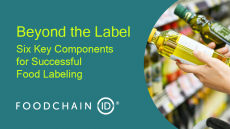Traffic light scheme advances onto menus
restaurants to use its traffic light scheme - intended for food
manufacturers - on menus, indicating progress in raising awareness
for the healthier eating message.
The FSA's scheme was developed for food manufacturers and retailers, and is intended to help consumers make 'at a glance' healthy food choices.
This highly visual approach presents a red light on foods high in a nutrient we should be trying to cut down on (like salt, sugar or saturated fat); amber as a not high-or-low, OK choice; and green foods that are low in a nutrient we should try to cut down on.
"We will be interested to see how YO!
Sushi customers react to having traffic lights on the menu," said the agency, which also expressed hope that other restaurants and caterers will sign up too.
This is not the first time that a trend or concept has crossed over between manufacturing and catering.
In New York and other parts of the United States, for instance, food industry efforts to reformulate products to contain less trans fatty acids has coincided with trans fat bans in restaurants.
The media attention that accompanied the ban in restaurants did much to raise awareness of the health issues associated with trans fat consumption (which have been strongly linked to an increased risk of cardiovascular disease).
The FSA has made considerable investment in communicating the traffic light scheme to consumers -including advertisements on buses in London.
Yo!
Sushi will, amongst its diners, at least, contribute to that effort with the distribution of leaflets explaining the system.
However traffic light labelling has proved rather controversial, partly because the nutrient profiling system that underpins it has been criticised as being "unscientific" .
Other critics have said it is too judgmental, as a high fat content, for instance, could be flagged on a product that is also a very good source of calcium.
While more than 50 manufacturers in the EU have signed up, instead, to the CIAA's Guidance Daily Amount (GDA) scheme, which gives actual figures for nutrients on the front of pack, retailer ADSA has opted for a system that combines both the visual and the detailed information approach.














